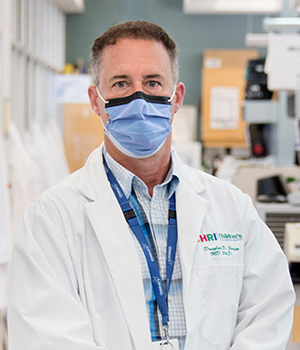Research: Concussion blood test begins pivotal clinical trial

By Emily Leighton, MA'13
An innovative concussion blood test developed by researchers at Western University is set to begin a pivotal clinical trial with the Food & Drug Administration in the U.S. in the coming weeks.
Leveraging biomarkers and artificial intelligence, the test could be a game changer for concussion diagnosis and management. Currently, there is no single test that can definitively provide a concussion diagnosis – testing methods are subjective, relying on self-reported symptoms and clinician judgement.
The non-invasive test uses a form of blood profiling called ‘metabolomics’ to identify distinct patterns in metabolites – small molecules – that indicate a concussion has occurred. With a few drops of blood from the prick of a finger, a sample is collected on a convenient filter paper device and, once submitted for lab analysis, compared to a baseline blood sample and a population reference.
It can determine if someone has suffered a concussion in about 20 minutes and has shown up to 96 per cent accuracy.
“We’re trying to make sure concussions aren’t missed,” explained Dr. Douglas Fraser, Professor in Paediatrics, Physiology and Pharmacology and Clinical Neurological Sciences, who is leading the development of the technology. “When a concussion is left untreated or a person suffers from multiple concussions, they are prone to long-lasting, debilitating symptoms.”
 This research first started at Western in 2015, bringing several interdisciplinary experts together, including Dr. Lisa Fischer, Mark Daley, PhD, and Kevin Shoemaker, PhD, as well as other members of the University’s concussion study team.
This research first started at Western in 2015, bringing several interdisciplinary experts together, including Dr. Lisa Fischer, Mark Daley, PhD, and Kevin Shoemaker, PhD, as well as other members of the University’s concussion study team.
In a preliminary study, the researchers collected blood samples from 12- to 14-year-old male hockey players, investigating a spectrum of 174 metabolites and showing a consistent pattern when players were concussed.
In March 2020, Fraser co-founded Neurolytixs to commercialize the research. Working with WORLDiscoveries, the findings have been licensed and patented around the world.
The upcoming two-part clinical trial seeks to validate the group’s findings independently. The first phase will establish age and sex population references for the metabolites, something that’s never been done before. The second phase is a multi-centre, blinded trial following male and female athletes aged 13 to 17 years through a season of play.
“If we can show a similar degree of accuracy with the test, we should have a product to market in the next two to three years,” said Fraser.
The clinician-scientist projects a potential annual revenue of $1.4 billion in North America alone. “This is a great example of innovation,” he said. “We’ve taken the initial research findings, driven them forward to industry and hopefully, we can make a big impact. We see a higher number of concussions in this adolescent age group, so it’s a population that needs to be protected.”
As part of the clinical trial, Neurolytixs is also investigating if the blood test can track recovery and inform return-to-play decisions. Following non-injured adolescent athletes through a season of play, the research team will be performing multiple checks to verify that metabolites have not changed, and if a player is concussed, tracking how well their biochemical recovery correlates with their clinical recovery.
The Neurolytixs test is one of several in development to accurately diagnose and assess concussion. From saliva to urinalysis, research teams around the world are racing to bring a reliable product to market – although there are very few competitors working with the adolescent population.
“If anyone can do it, we can,” said Fraser. “The progress we’ve made in less than two years, in the middle of a pandemic, it’s been remarkable.”
In another project, Fraser and his team are working with the Canadian military on a test for blast injury, a type of trauma that results from exposure to an explosion like breaching a door, detonating a grenade, or firing a high-calibre weapon. The team is exploring two testing approaches for this population using blood and exhaled breath.
A paediatric critical care physician, Fraser says his experiences in trauma care led him to pursue brain injury research.
“We would discharge children after addressing their visible injuries, fixing their broken bones, only to find out later that their grades were slipping or they were suffering from depression,” he said. “Concussions threaten the long-term brain health of children, as well as athletes and military personnel.”









